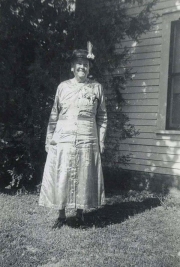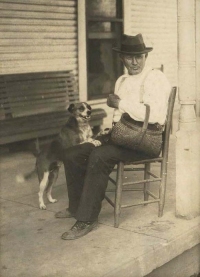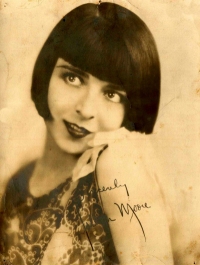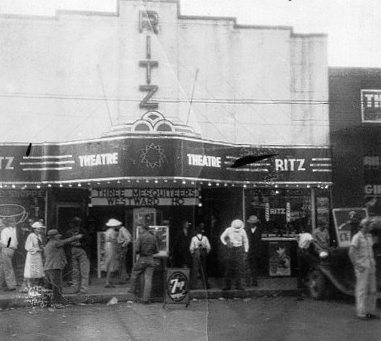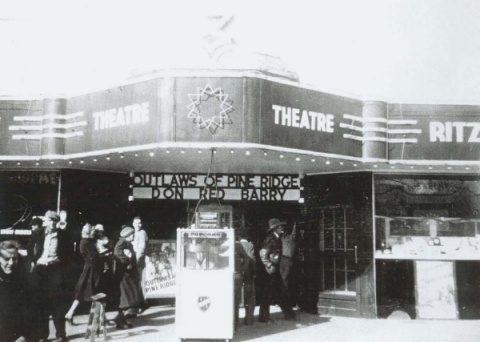Mike Brown was a
hard-working young man who not only helped with the running of the Dixie
Theater at night, but drove a taxi during the day. The Browns owned two
taxis. Both were Model T Fords and one was driven for the Browns by Luke
Copeland. The taxis made many trips to the train depot in Livingston,
picking up distinguished visitors who came to stay at the Brown Hotel.
Among those who came from places such as Washington, D.C. to Livingston
was none other than Cordell Hull. Colleen remembers when she was around 3
or 4 years-old how she would get to ride in the taxi with Cordell Hull and
he
would say to her, "Come sit on my lap, you can't see out." Colleen said
Mr. Hull always wore a bowler hat and smoked a big cigar. His shirts had a
celluloid collar with a little leather bow tie. He hired the
Brown taxi to drive him around the area when he came to Livingston from
Washington.But life at the Brown Hotel and
the Dixie Theater had problems as well as being a place of entertainment.
After both daughters were born to Mike and Clarice Brown, they moved into
and shared the home of Russell Dale, whose house was on the right side of
what came to be known as the Floyd Davis house. The Russell Dale home was
a large white house that was torn down many years ago. While living at the
Russell Dale home, and when Colleen was only 5 years-old, the whole family
came down with smallpox, and this included Colleen's younger sister,
Marinella, who was only 7 days-old at the time. Colleen remembers that the
house was quarantined for three months with a sign on the front of the
house warning others to stay away. Boxes of food were left on the porch by
Mrs. Belle Brown and were scooted near the door with a long pole.
Mike Brown brought the smallpox germ home with him following a visit to
North Carolina, where his mother-in-law, Ida (Oakley) Brown, had been
taken to a tuberculosis sanatorium after coming down with that disease.
Mike Brown had driven his father-in-law, Marvin Brown, over to visit Ida
Brown, and while in North Carolina, Mike went to a barber shop for a
haircut. A shoe shine man who worked in the barber shop was polishing
Mike's shoes while he was having his hair cut, and Mike noticed sore
places on the man's arms. When he asked what was wrong, the fellow
replied, "I don't rightly know, they just come up on me." Smallpox for the
whole family was the result of that shoe shine, but in time, the family
all recovered from this much feared disease.
As a small girl, Colleen also told me about riding
in a horse-drawn surrey with a fringe top owned by Mrs. Cora Qualls, wife
of Elvin Qualls. Mrs. Qualls sold food items to homes and businesses in
Livingston, and the surrey was what could be considered a rolling grocery
store, with things such as butter, eggs, milk, and fresh chickens for
sale. Colleen was very helpful to Mrs. Qualls in that she was the one who
got down
from the surrey and took whatever item was being purchased to the doors of
the homes and businesses that were regular customers of Mrs. Qualls.
The Dixie Theater quickly became a place where
crowds of people gathered, especially on Nickel Night. Many businesses
around the square in Livingston would give a ticket to the theater with
purchases of $3 or more, and with this ticket, plus five cents, folks
could get in to see the movie. On Nickel Night, it was always a standing
room only crowd. Folks would be admitted until not another person could be
squeezed in, even standing up. Mrs. Clarice Brown had a soft heart when it
came to little boys who had no money to get in to see the show. Colleen
remembers that all a little boy had to do was drop his head and look
pitiful and her mother would say, "Do you want to see the show? Well, go
on in and get yourself a bag of popcorn, too."
Colleen had a number of jobs over the years in the
theater business, one of which an apron her mother made for her to wear
was used. The apron had two pockets sewn on it, and in those two pockets,
nickels were placed. It was Colleen's job to put the nickels in the player
piano that played while the silent movies came across the screen. She
wasn't big enough to reach the slot on the piano to place the nickels in,
so she had to stand on a box.
On other occasions, a black fellow named Lans Allen,
would play the piano before the show started. Lans Allen and his wife
cooked at the Brown Hotel. Marinella and Colleen would sometimes tap dance
while Lans Allen played the piano before the shows began. And this tap
dancing gave Marinella an idea once on how she and Colleen could make some
money of their own. They walked up the street to the corner
of the square, where Morgan's Department Store used to be located, and
Marinella danced on the street corner while Colleen fanned her feet,
something Marinella told her to do so anyone passing would think she was
really doing a terrific job dancing. Then Colleen used the hat she was
fanning Marinella's feet with to collect money in. They got quite a little
bit of change before their mother somehow found out what was going on.
Clarice Brown marched up to the street corner and got them, and all the
way home, she gave each one a good whipping. Needless to say, they didn't
dance on the corner anymore.
As she got older, Colleen also had jobs such as
popping and selling popcorn, selling tickets, and taking up tickets from
customers as they came into the theater. From around the age of 10
years-old up until she finished high school, she was involved in helping
run the theater. Friday nights were also the night Grand Old Opry stars
would come to the Dixie Theater. Lots of the what we would refer to now as
the older stars of the Opry made several appearances at the Dixie, and
include such well known names as Minnie Pearl, Grandpa Jones, and the
Everly Brothers, just to mention a few. Gene Autry appeared there once,
and the famous film star, Tex Ritter, came and stayed at the Brown Hotel
for a couple of weeks during his appearance at the Dixie Theater. Before
Tex Ritter departed from his visit in Livingston, he bought gifts for the
Brown girls. Marinella got a doll and because she was older, Colleen got a
box of candy. Colleen said she was resentful of Marinella's gift because
she knew when she ate all the candy, her gift would be gone, and Marinella
would always be able to keep hers.
|
